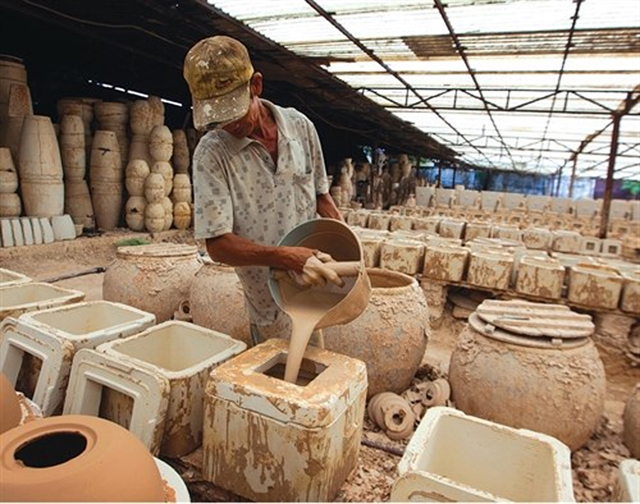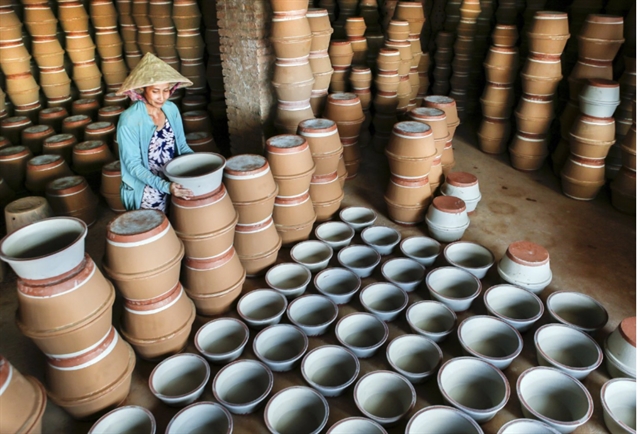 Society
Society

 |
| A worker pours clay in a mold in a ceramic workshop in Tân Phước Khánh Village of Bình Dương Province. VNA/VNS Photo |
Tố Như
HÀ NỘI – Traditional craft villages and rural industries not only create jobs and bring economic value to rural workers, but also are a convergence and crystallisation of historical and cultural values of that land and local people.
For craft villages and rural industries to develop, raw materials play an extremely important role.
According to the Ministry of Agriculture and Rural Development's Department of Economic Co-operation and Rural Development, currently, rural industry has a turnover of VNĐ202 trillion (US$8.5 billion), down VNĐ11.6 trillion compared to 2020.
The total number of production and business establishments is 808,201, a decrease of 4,705 establishments compared to 2020, while per capita income is VNĐ5 million per year and exports of products and raw materials reach about $3.3 billion.
The country has about 2008 recognised craft and traditional villages, an increase of 80 from 2020 with total turnover of VNĐ75.7 trillion, an increase of VNĐ17.3 trillion compared to 2020.
The number of production and business establishments in craft and traditional villages is 270,760, an increase of 59,705 establishments compared to 2020, creating jobs for about 1.58 million workers with per capita income of VNĐ5-6 million per year.
Currently, the products of craft villages and rural industries are made from many different sources of raw materials from farming, planting and natural exploitation to industrial raw materials.
The use of many types of raw materials in one product has formed an increasingly close association between the raw material suppliers and the production facilities of craft villages.
However, the raw material areas have narrowed due to competition with other crops and are under pressure from the process of urbanisation and industrialisation.
Lê Đức Thịnh, director of the Department of Economic Co-operation and Rural Development, said that for raw materials of bamboo serving the bamboo knitting villages, the average output is currently 500 to 600 million trees per year, while consumption demand is from 900 to 1,000 million trees per year.
Therefore, many businesses and craft villages have to import raw materials from China, Laos and Cambodia, Thịnh said.
For rattan raw materials, annual demand is about 80,000 tonnes with an output of about 3.5 tonnes per hectare, so an area of 23,000ha is needed.
Rattan is mainly exploited from nature and has become very scarce due to over-exploitation and lack of management.
The lack of concentrated and large-scale planting areas leads to a lack of stability in the supply of raw material.
Countries with a lot of rattan material in the world, such as Indonesia and Laos, have banned the export of rattan raw material, so Vietnamese enterprises have a serious shortage of raw material, he said.
Currently, there are 173 recognised embroidery and weaving villages nationwide.
Materials for embroidery and weaving include silk, cotton, flax, lotus silk, and banana fiber.
It is difficult to expand raw material growing areas due to competition with other crops of higher economic value, which is a challenge for embroidery and weaving villages.
Processing technology has not yet reached high-grade silk, while many other materials have to be imported in large quantities, such as cotton (98 per cent) and embroidered fabrics.
The country has 37 ceramic villages. Raw materials for production are mainly kaolin and clay.
Total demand for ceramic materials is more than 1.9 million tonnes per year. Hà Nội alone has demand of about 600,000 tonnes per year.
Currently, producers have to import a large quantity of high-quality raw materials from mainland China and Taiwan at very high prices.
According to Thịnh, although there is a good clay factory, there is no good kaolin factory, so it is impossible to create good materials because these two materials always have to be mixed together to create raw materials for ceramic production.
On the other hand, raw materials are becoming more and more scarce due to planning for housing construction in areas with raw materials.
At present, the reserve of raw material mines supplying ceramic production establishments in Bình Dương Province is also decreasing rapidly.
Thịnh said: “Currently, there are many shortcomings and problems in the development of raw material areas for craft villages.”
“Specifically, localities do not have long-term development plans or programmes to develop concentrated and large-scale raw material areas to serve enterprises, craft villages and rural industries,” Thịnh said.
“Many plant varieties are being degraded, such as bamboo and rattan, while raw material growing areas have not been proactive in seedling and breeding sources such as bamboo, rattan and silkworm varieties. And there are not many new high-yield and high-quality varieties,” he said.
There has not been much linkage in production in raw material growing areas with the orientation of forming co-operatives, co-operative groups and linking farmers with businesses to purchase products.
Semi-processing and processing factories, craft villages and businesses are often located far away from raw material areas, leading to difficulties in purchasing and selling raw materials.
The technology for semi-processing and processing of raw materials is still backward, resulting in inconsistent products in terms of quality that are less competitive, especially in export markets.
Linkage is the key
 |
| A ceramic workshop in Bình Dương Province. Photo luhanhvietnam.com.vn |
For craft villages to develop, the raw material area serving the production plays an extremely important role.
Because, if there are no good materials, it will not be possible to create quality products and be proactive in production.
More importantly, the raw material areas for rural industries are places to retain workers and create sustainable livelihoods for people in rural areas.
Deputy Minister of Agriculture and Rural Development Trần Thanh Nam said that it is necessary to synchronously implement solutions on planning material areas, formation of chain links, investment and science and technology application and innovation in production and breeding and seedling activities.
On the other hand, the weakness of businesses today is that they have not taken full advantage of their advantages when setting foot in a locality to form links and develop sustainably, said Nam.
“In order to develop raw material areas, craft villages and rural industries have no choice but to form linkage chains,” Nam said.
“Local authorities need to soon develop specific planning and policies to support raw material areas,” he added.
Lê Bá Ngọc, general secretary of Việt Nam Handicraft Exporters’ Association (VIETCRAFT), said that it is necessary to develop raw material areas based on the advantages of each locality and region with traceable origins.
“It is necessary to harmoniously combine many scales and give priority to the development of concentrated specialised farming areas in combination with household economic development models in order to maintain stable raw material areas and generate income for households,” said Ngọc.
“In addition, research on improving varieties and planting techniques to create good quality raw materials suitable for handicraft products are needed,” he said.
“The diversification of forms of ownership of raw material areas should be taken into consideration to create conditions for production and business establishments, especially export business enterprises in craft villages, to participate in the development of raw material areas in the form of public-private partnerships,” he added. VNS




